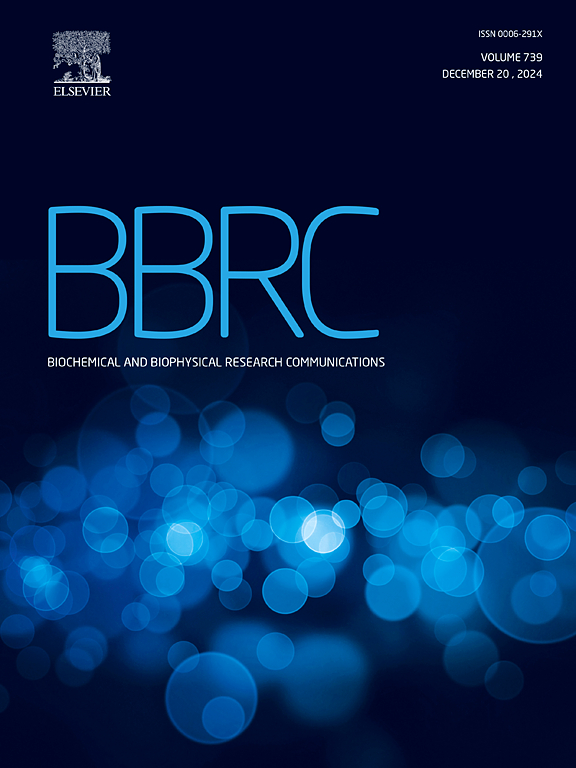A novel combined oxidative stress and extracellular matrix related predictive gene signature for keratoconus
IF 2.5
3区 生物学
Q3 BIOCHEMISTRY & MOLECULAR BIOLOGY
Biochemical and biophysical research communications
Pub Date : 2025-01-01
DOI:10.1016/j.bbrc.2024.151144
引用次数: 0
Abstract
Keratoconus (KC) is an ectatic cornea disease with high prevalence and asymptomatic at early stage, leading to decreased visual acuity and even cornea transplantation. However, the etiology mechanism of keratoconus is still poorly understood. Oxidative stress (OS) and extracellular matrix (ECM) remodeling play critical roles in keratoconus development. Here, based on keratoconus datasets from GEO database, we obtained 454 differentially expressed genes (DEGs), which were further intersected with oxidative stress (OS) and extracellular matrix (ECM) genesets from MSigDB database. A total of 17 OS- and ECM-related DEGs (OEDEGs) were identified. Feature genes were screened by least absolute shrinkage and selection operator (LASSO) and support vector machine recursive feature elimination (SVM-RFE) algorithms, and a six-gene (COL1A1, CYP1B1, MMP3, HMOX1, FOS and GDF15) classification model was developed utilizing Logistic regression (LR), Support Vector Machine (SVM) and Naïve Bayes (NB) algorithms respectively, which was further verified in internal and external cohort. Subsequently, a predictive nomogram was constructed for KC patients. Six signature genes showed a strong correlation with the infiltration level of macrophages M1, neutrophils and eosinophils. Additionally, in vitro qRT-PCR validated the decreased expression of signature genes in either keratoconus clinical samples or human cornea epithelial (HCE) cells grown on soft hydrogel substrate. Finally, we revealed that CYP1B1 and GDF15 regulate cellular proliferation and response to oxidative stress. In conclusion, the developed combined OS and ECM gene signature showed excellent performance for keratoconus prediction, providing beneficial perspectives for keratoconus pathogenesis.
一种新的联合氧化应激和细胞外基质相关的圆锥角膜预测基因标记。
圆锥角膜(Keratoconus, KC)是一种发病率高、早期无症状的扩张性角膜疾病,可导致视力下降,甚至角膜移植。然而,圆锥角膜的病因机制尚不清楚。氧化应激(OS)和细胞外基质(ECM)重塑在圆锥角膜的发育中起关键作用。在此,我们基于GEO数据库中的锥形角膜数据集,获得了454个差异表达基因(deg),并将其与MSigDB数据库中的氧化应激(OS)和细胞外基质(ECM)基因集进一步交叉。共鉴定出17个与OS和ecm相关的deg (oedeg)。采用最小绝对收缩和选择算子(LASSO)和支持向量机递归特征消除(SVM- rfe)算法筛选特征基因,分别利用Logistic回归(LR)、支持向量机(SVM)和Naïve贝叶斯(NB)算法建立六基因(COL1A1、CYP1B1、MMP3、HMOX1、FOS和GDF15)分类模型,并在内部和外部队列中进一步验证。随后,构建了KC患者的预测图。6个特征基因与巨噬细胞M1、中性粒细胞和嗜酸性粒细胞的浸润水平有很强的相关性。此外,体外qRT-PCR验证了在软水凝胶底物上生长的圆锥角膜临床样本或人角膜上皮细胞中特征基因的表达降低。最后,我们发现CYP1B1和GDF15调节细胞增殖和对氧化应激的反应。综上所述,所建立的OS和ECM联合基因标记在圆锥角膜预测方面表现出色,为圆锥角膜的发病机制提供了有益的视角。
本文章由计算机程序翻译,如有差异,请以英文原文为准。
求助全文
约1分钟内获得全文
求助全文
来源期刊
CiteScore
6.10
自引率
0.00%
发文量
1400
审稿时长
14 days
期刊介绍:
Biochemical and Biophysical Research Communications is the premier international journal devoted to the very rapid dissemination of timely and significant experimental results in diverse fields of biological research. The development of the "Breakthroughs and Views" section brings the minireview format to the journal, and issues often contain collections of special interest manuscripts. BBRC is published weekly (52 issues/year).Research Areas now include: Biochemistry; biophysics; cell biology; developmental biology; immunology
; molecular biology; neurobiology; plant biology and proteomics
文献相关原料
公司名称
产品信息
索莱宝
0.2 mg/ml collagen I solution
索莱宝
10 ng/ml human EGF

 求助内容:
求助内容: 应助结果提醒方式:
应助结果提醒方式:


